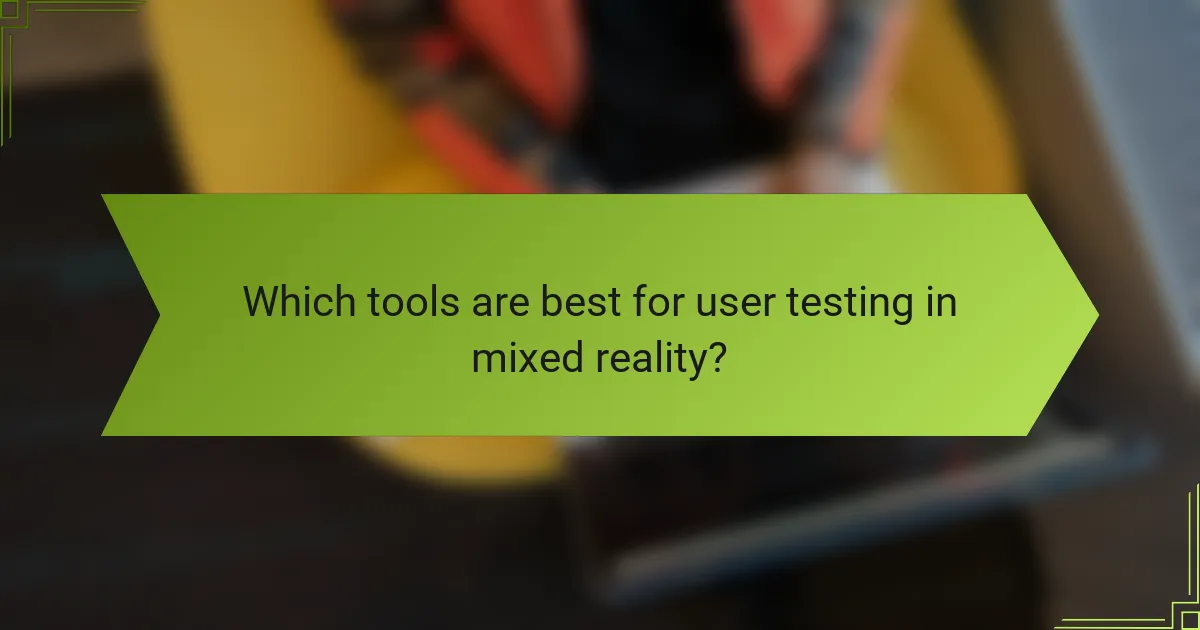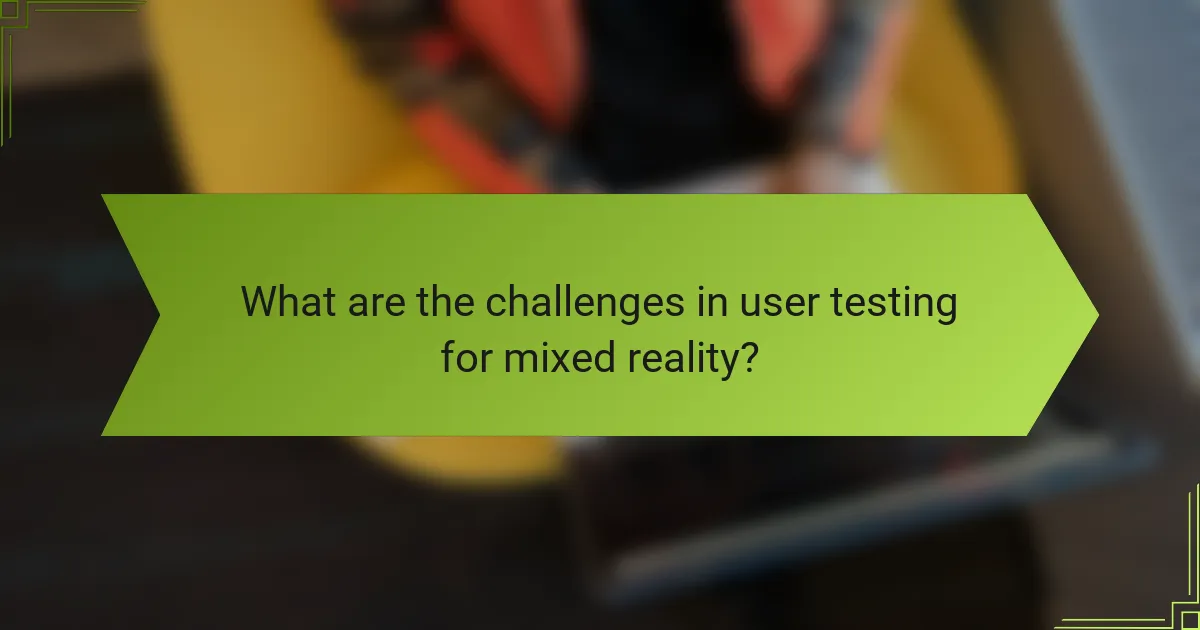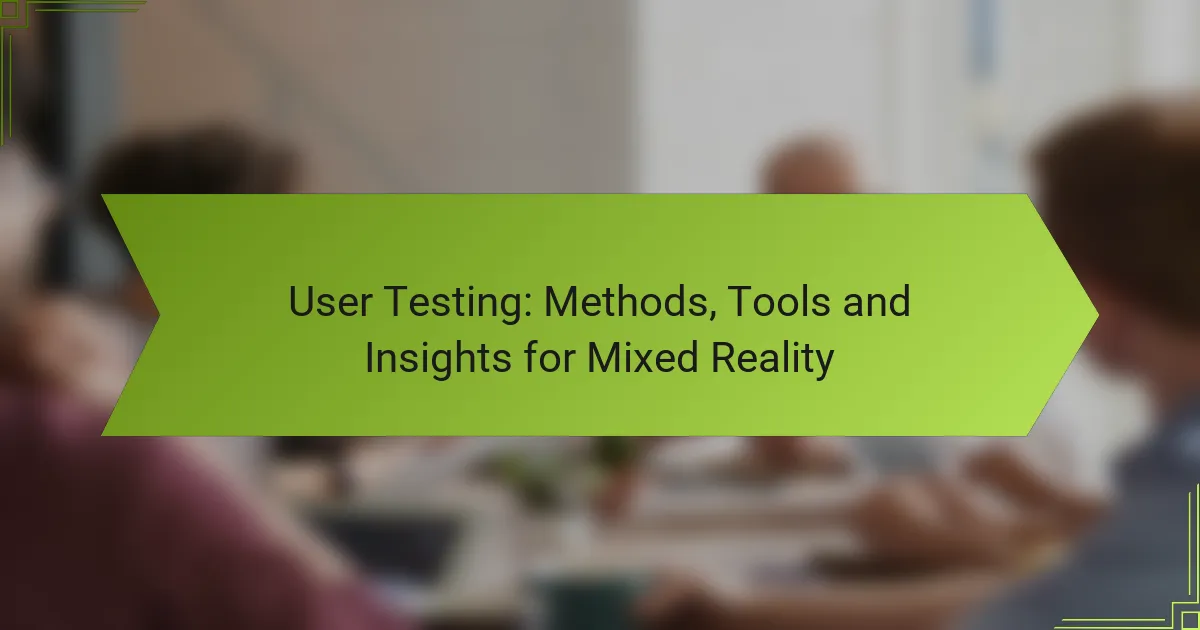User testing is crucial for optimizing mixed reality experiences, employing methods such as usability testing, A/B testing, and focus groups to gather valuable insights. By utilizing specialized tools, developers can accurately capture user interactions and feedback, leading to informed design decisions. Analyzing both quantitative and qualitative data from these tests enables the identification of usability issues and enhances overall user engagement.

What are effective user testing methods for mixed reality?
Effective user testing methods for mixed reality include usability testing, A/B testing, remote testing, focus groups, and field studies. Each method offers unique insights into user interactions and experiences, helping developers refine their applications for better engagement and usability.
Usability testing
Usability testing involves observing real users as they interact with a mixed reality application to identify any issues or challenges they face. This method typically includes tasks that users must complete while facilitators note their behaviors and feedback. Aim for a sample size of 5-10 users to uncover the majority of usability problems.
Key considerations include defining clear objectives for the test, preparing realistic scenarios, and ensuring a comfortable environment for participants. Common pitfalls include overloading users with tasks or failing to ask follow-up questions to clarify their experiences.
A/B testing
A/B testing compares two versions of a mixed reality experience to determine which performs better based on user engagement metrics. This method is particularly useful for optimizing design elements, such as user interfaces or interaction methods. Ensure you have a sufficient sample size to achieve statistically significant results.
When conducting A/B tests, focus on one variable at a time to isolate its impact. Avoid making assumptions about user preferences; instead, rely on data to guide decisions. A common mistake is running tests for too short a duration, which can lead to inconclusive results.
Remote testing
Remote testing allows users to interact with a mixed reality application in their own environment, providing insights into real-world usage. This method can be conducted through screen-sharing tools or specialized software that records user interactions. It is particularly beneficial for reaching a diverse user base across different locations.
To conduct effective remote testing, ensure that users have clear instructions and the necessary technology to participate. Be mindful of potential technical issues that could disrupt the testing process. A common challenge is the lack of immediate feedback, which can limit the depth of insights gained.
Focus groups
Focus groups gather a small group of users to discuss their experiences and perceptions of a mixed reality application. This qualitative method encourages open dialogue, allowing participants to share insights that may not emerge in individual testing. Aim for 6-10 participants to foster a dynamic discussion while keeping the group manageable.
When facilitating focus groups, prepare guiding questions but remain flexible to explore unexpected topics. Record sessions for later analysis, but ensure participants consent to this. A common pitfall is dominating the conversation, which can stifle participant input and skew results.
Field studies
Field studies involve observing users in their natural environments as they interact with a mixed reality application. This method provides context-rich insights into how users engage with the technology in real-life scenarios. Plan for a longer duration to capture varied interactions and behaviors.
Key steps include selecting appropriate locations, obtaining user consent, and ensuring that observers do not interfere with the natural flow of interaction. A challenge of field studies is managing the variability of environments, which can affect user experiences. Be prepared to adapt your analysis based on the context of use.

Which tools are best for user testing in mixed reality?
Effective user testing in mixed reality (MR) requires specialized tools that can capture user interactions and feedback accurately. The best tools facilitate observation, analysis, and iterative improvements to enhance the user experience in MR environments.
Lookback
Lookback is a user research platform that enables real-time observation of participants as they interact with mixed reality applications. It allows researchers to record sessions, gather feedback, and analyze user behavior through video and audio capture.
Consider using Lookback for remote testing, as it supports live interactions and can be integrated with various MR devices. This tool is particularly useful for understanding user emotions and reactions during the testing process.
UserTesting
UserTesting provides a comprehensive platform for gathering user insights through recorded sessions and feedback. It allows you to create tasks for participants to complete while using your mixed reality application, capturing their thoughts and experiences in real-time.
This tool is beneficial for identifying usability issues and understanding user expectations. UserTesting’s extensive panel of users can help you reach diverse demographics, ensuring that your MR product meets a wide range of needs.
Optimal Workshop
Optimal Workshop offers a suite of usability testing tools designed to improve user experience through card sorting, tree testing, and first-click testing. While it is not MR-specific, its methods can be adapted to assess the information architecture of MR applications.
Utilize Optimal Workshop to understand how users navigate and interact with content in your mixed reality environment. Its insights can guide the design of intuitive interfaces that enhance user engagement.
Maze
Maze is a rapid testing platform that allows you to create prototypes and test them with real users. It provides quantitative data on user interactions, such as task completion rates and time on task, which are essential for evaluating mixed reality experiences.
Use Maze to validate design concepts quickly and iterate based on user feedback. This tool is particularly useful for teams looking to streamline their testing processes and make data-driven decisions.
Unity Test Framework
The Unity Test Framework is a powerful tool for developers working on mixed reality applications within the Unity environment. It supports unit testing and integration testing, ensuring that your MR applications function correctly before user testing.
Incorporate the Unity Test Framework to catch bugs early and improve the overall quality of your MR product. Regular testing can save time and resources by identifying issues that may affect user experience during testing sessions.

How to analyze user testing insights for mixed reality?
Analyzing user testing insights for mixed reality involves interpreting both quantitative and qualitative data to improve user experience. This process helps identify usability issues and informs design decisions based on user interactions and feedback.
Quantitative analysis
Quantitative analysis focuses on numerical data collected during user testing, such as task completion rates, time on task, and error rates. These metrics provide a clear picture of user performance and can highlight areas needing improvement.
To conduct quantitative analysis, gather data from multiple sessions to ensure reliability. Use statistical methods to interpret the results, looking for trends or significant deviations that indicate usability problems.
Qualitative feedback
Qualitative feedback captures users’ thoughts, feelings, and experiences during testing. This can be obtained through interviews, open-ended survey questions, or observation notes. Such insights are crucial for understanding the context behind user behaviors.
When analyzing qualitative feedback, look for common themes or patterns in user comments. This can help pinpoint specific pain points or areas of satisfaction, guiding design improvements that enhance user engagement.
User journey mapping
User journey mapping visualizes the steps a user takes while interacting with a mixed reality application. This tool helps identify touchpoints, emotions, and potential friction in the user experience.
To create an effective user journey map, gather data from user testing sessions and outline each stage of the interaction. Highlight key moments where users experience confusion or frustration, as these are critical areas for redesign or enhancement.
Heatmaps
Heatmaps provide a visual representation of user interactions within a mixed reality environment, showing where users focus their attention and how they navigate through the application. This data can reveal hotspots of engagement as well as areas that are overlooked.
When utilizing heatmaps, consider using tools that integrate with your mixed reality platform. Analyze the heatmap data to adjust layouts, improve navigation, and enhance overall usability based on user behavior patterns.

What are the challenges in user testing for mixed reality?
User testing for mixed reality (MR) presents unique challenges that can affect the effectiveness and reliability of the results. Key issues include technical limitations, user discomfort, and data privacy concerns, each of which can hinder the testing process and impact user experience.
Technical limitations
Technical limitations in mixed reality often arise from hardware constraints, such as processing power and display quality. Devices may struggle to render complex environments smoothly, leading to lag or visual artifacts that can skew user feedback.
Additionally, compatibility issues between different MR platforms can complicate testing. Ensuring that applications function seamlessly across various devices is crucial for gathering accurate data. Testing should include a range of devices to identify potential discrepancies.
User discomfort
User discomfort is a significant challenge in mixed reality testing, as prolonged use can lead to issues like motion sickness or eye strain. These physical reactions can affect user performance and skew results, making it essential to monitor user feedback closely during sessions.
To mitigate discomfort, testers should limit session lengths to around 20-30 minutes and provide breaks. It’s also helpful to gather qualitative feedback on user experiences to better understand discomfort triggers and adjust the testing environment accordingly.
Data privacy concerns
Data privacy concerns are paramount in mixed reality user testing, especially when collecting sensitive information or biometric data. Adhering to regulations such as GDPR in Europe or CCPA in California is critical to ensure user trust and compliance.
To address these concerns, testers should be transparent about data collection practices and obtain informed consent from participants. Implementing robust data security measures and anonymizing data can further protect user privacy and enhance the credibility of the testing process.
